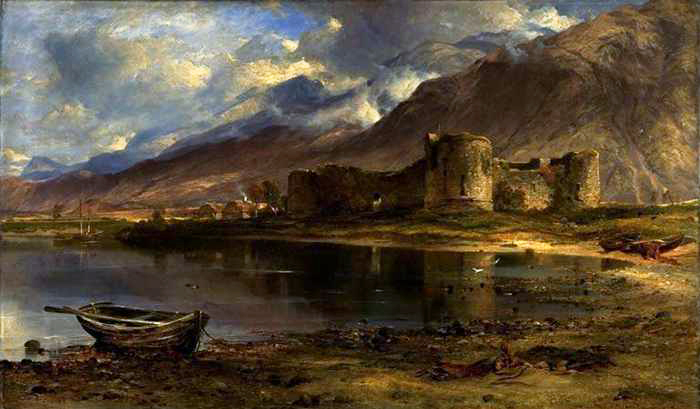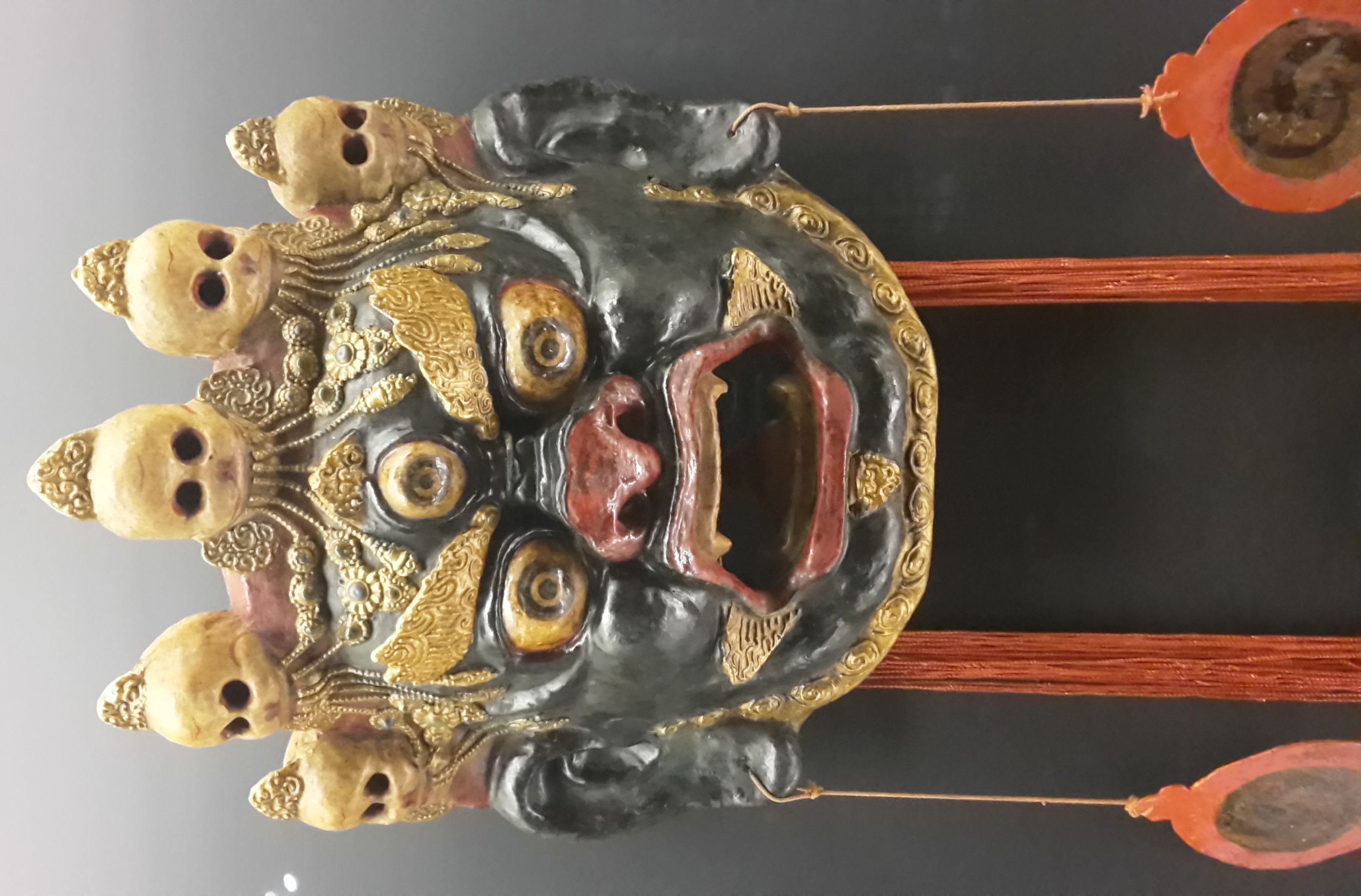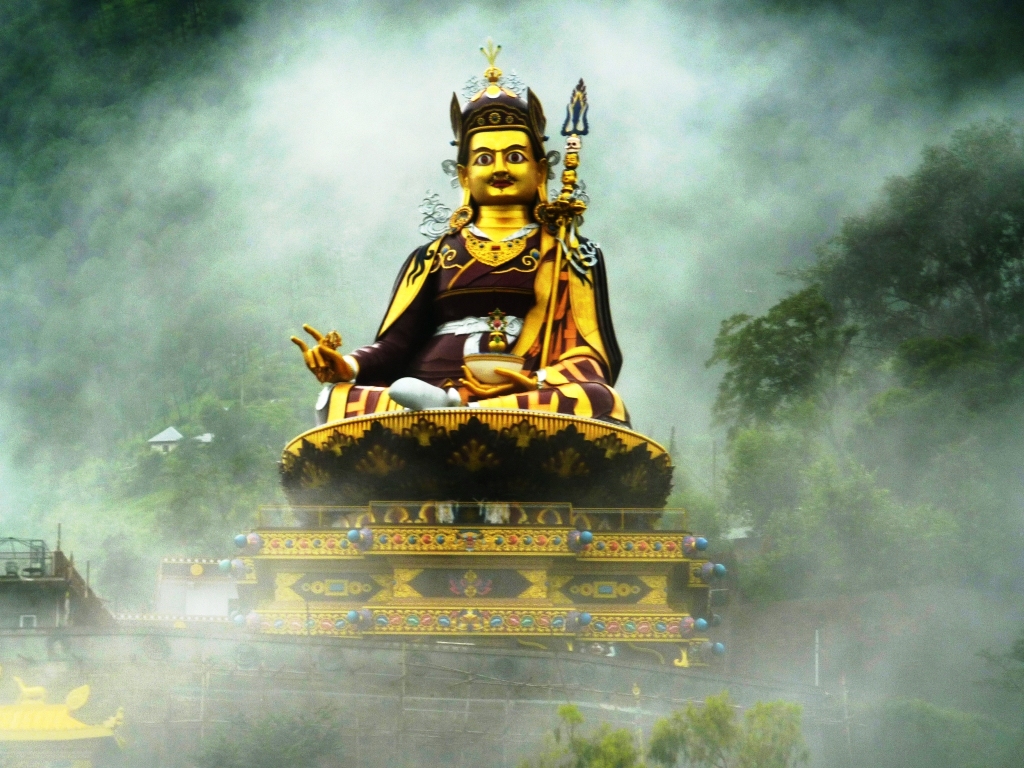|
Namchö Mingyur Dorje
Namchö Mingyur Dorje (; 1645–1667) was a Tibetan tertön or "treasure revealer" in Tibetan Buddhism. His extraordinary "pure vision" revelations, which mostly occurred around the age of 16, are known as the Namchö ( "Sky Dharma" terma. He first transmitted these to his teacher Karma Chagmé (, 1613-1678), the illustrious Buddhist scholar of the Kagyu school, who wrote them down. He showed signs of illness at age 23, which progressed to his mind stream dissolving in to the great sphere of empty truth with full eight Heruka vision and mandalas. He was also known as Drakpo Nuden Tsel, Mingyur Dorje, Terton Mingyur Dorje, and Terton Sherab Mebar. Works The collection of his revelations fill thirteen Tibetan volumes and are the basis of one of the main practice traditions of the Palyul lineage, a major branch of the Nyingma school of Tibetan Buddhism. He was considered to be a reincarnation of Palgyi Senge of Shubu, one of the ministers the 8th-century Tibetan King Trisong D ... [...More Info...] [...Related Items...] OR: [Wikipedia] [Google] [Baidu] |
Tibetan Language
Tibetan language may refer to: * Lhasa Tibetan or Standard Tibetan, the most widely used spoken dialect * Classical Tibetan, the classical language used also as a contemporary written standard * Any of the other Tibetic languages See also * Old Tibetan, the language used from the 7th to the 11th century * Central Tibetan language, which forms the basis of Standard Tibetan * Khams Tibetan, spoken in the south-east * Amdo Tibetan, spoken in the north-east * Tibetan (other) * Bhoti (other), various Tibetan languages {{disambig ... [...More Info...] [...Related Items...] OR: [Wikipedia] [Google] [Baidu] |
Trisong Detsen
Trisong Detsen () was the son of Me Agtsom, the 37th king of Tibet. As the 38th king, he ruled from AD 755 until 797. Trisong Detsen was the second of the Three Dharma Kings of Tibet — Songsten Gampo, Trisong Detsen, Rapalchen — honored for their pivotal roles in the introduction of Buddhism to Tibet and the establishment of the Nyingma or "Ancient" school of Tibetan Buddhism. ''Sowa Rigpa'' or Traditional Tibetan medicine was developed during his reign. Trisong Detsen became one of Tibet's greatest kings during its empire era, and an unparalleled Buddhist benefactor to Guru Padmasambhava, to Khenpo Shantarakshita, to his court, and to the founding of the Vajrayana. By the end of his reign, he grew the extents of Tibet beyond their previous borders, reset the borders between Tibet and China in 783, and even occupied the capital of China at Chang'an, where he installed a king. Claude Arpi, ''Glimpses of the Tibet History'', Dharamsala: The Tibet Museum, 2016, Chapter 6, "A ... [...More Info...] [...Related Items...] OR: [Wikipedia] [Google] [Baidu] |
17th-century Buddhists
The 17th century lasted from January 1, 1601 (represented by the Roman numerals MDCI), to December 31, 1700 (MDCC). It falls into the early modern period of Europe and in that continent (whose impact on the world was increasing) was characterized by the Baroque cultural movement, the latter part of the Spanish Golden Age, the Dutch Golden Age, the French ''Grand Siècle'' dominated by Louis XIV, the Scientific Revolution, the world's first public company and megacorporation known as the Dutch East India Company, and according to some historians, the General Crisis. From the mid-17th century, European politics were increasingly dominated by the Kingdom of France of Louis XIV, where royal power was solidified domestically in the civil war of the Fronde. The semi-feudal territorial French nobility was weakened and subjugated to the power of an absolute monarchy through the reinvention of the Palace of Versailles from a hunting lodge to a gilded prison, in which a greatly expanded ro ... [...More Info...] [...Related Items...] OR: [Wikipedia] [Google] [Baidu] |
1667 Deaths
Events January–March * January 11 – Aurangzeb, monarch of the Mughal Empire, orders the removal of Rao Karan Singh as Maharaja of the Bikaner State (part of the modern-day Rajasthan state of India) because of Karan's dereliction of duty in battle. * January 19 – The town of Anzonico in Switzerland is destroyed by an avalanche. * January 27 – The 2,000 seat Opernhaus am Taschenberg, a theater in Dresden (capital of the Electorate of Saxony) opens with its first production, Pietro Ziani's opera ''Il teseo''. * February 5 – In the Second Anglo-Dutch War, the English Royal Navy warship HMS ''Saint Patrick'' is captured less than nine months after being launched, when it fights a battle off the coast of England and North Foreland, Kent. Captain Robert Saunders and 8 of his crew are killed while fighting the Dutch ships ''Delft'' and ''Shakerlo''. The Dutch Navy renames the ship the ''Zwanenburg''. * February 6 (January 27 O.S.) – ... [...More Info...] [...Related Items...] OR: [Wikipedia] [Google] [Baidu] |
1645 Births
Events January–March * January 3 – The Long Parliament adopts the ''Directory for Public Worship'' in England, Wales, Ireland and Scotland, replacing the Book of Common Prayer ( 1559). Holy Days (other than Sundays) are not to be observed. * January 10 – Archbishop of Canterbury William Laud is executed for treason on Tower Hill, London. * January 14 – English Civil War: Thomas Fairfax is appointed Commander-in-Chief of the Parliamentarians. * January 29 – English Civil War: Treaty of Uxbridge, Armistice talks open at Uxbridge. * February 2 – Battle of Inverlochy (1645), Battle of Inverlochy: The Scottish Covenanters are defeated by James Graham, 1st Marquess of Montrose, Montrose. * February 15 – English Civil War: The New Model Army is officially founded. * February 28 – English Civil War: The Uxbridge armistice talks fail. * March 4 – English Civil War: Prince Rupert of the Rhine, Prince Rupert leaves Oxford for B ... [...More Info...] [...Related Items...] OR: [Wikipedia] [Google] [Baidu] |
Tibetan Buddhist Resource Center
The Buddhist Digital Resource Center (BDRC), formerly Tibetan Buddhist Resource Center (TBRC), is a 501(c)(3) nonprofit organization dedicated to seeking out, preserving, organizing, and disseminating Buddhist literature. Joining digital technology with scholarship, BDRC ensures that the ancient wisdom and cultural treasures of the Buddhist literary tradition are not lost, but are made available for future generations. BDRC is committed to seeking out, preserving, organizing, and disseminating Buddhist literature. Founded in 1999 by E. Gene Smith with the help of the Tibetan translator Michele Martin, BDRC is located in Cambridge, Massachusetts, and hosts a digital library of the largest collection of digitized Tibetan texts in the world. Current programs focus on the preservation of texts in Pali, Chinese, Sanskrit, and Tibetan. BDRC's Harvard Square headquarters facilitates its ongoing cooperative relationships with Harvard University. BDRC also has international offices in New De ... [...More Info...] [...Related Items...] OR: [Wikipedia] [Google] [Baidu] |
Rangjung Yeshe Wiki
The Rangjung Yeshe Wiki is a Wiki community established in 2005 focused on building a Tibetan-English Dictionary, glossaries of Buddhist terminology, biographies of Buddhist teachers, and articles on important Tibetan Buddhist literary works and collections. The site aims to develop resources useful for the "community of lotsawas" involved in translating Buddhist texts from Classical Tibetan to English and other European Languages. The original content of the Wiki was based on a digital Tibetan-English dictionary compiled by the translator Erik Pema Kunsang Erik Pema Kunsang (born Erik Hein Schmidt) is a Danish Dharma teacher and translator. He was, along with Marcia Binder Schmidt, director of Rangjung Yeshe Translations and Publications in Kathmandu Kathmandu () is the capital and larges ... in the early 1970s. The Rangjung Yeshe Wiki currently has over 23,720 articles, 1,060 uploaded files, and 825 registered users. The site is hosted and supported by the Tsadra Found ... [...More Info...] [...Related Items...] OR: [Wikipedia] [Google] [Baidu] |
The Treasury Of Lives
''The Treasury of Lives'' is an online, open access, peer reviewed, collection of biographical essays, which can be seen as an encyclopedia of historical figures from Tibet, Inner Asia, and the Himalayan Region. Background ''The Treasury of Lives'' is an online series of biographical essays, used as an encyclopedia, that was established in 2007 with the mission of providing open access to the lived history of Tibet and surrounding regions. Biographies are intended for a wide audience of scholars, independent researchers and practitioners. Essays cover a wide range of figures, from Buddhist masters to artists and political officials, most of which are peer reviewed. Website localization into Tibetan and Chinese languages in is progress in order to meet the growing numbers of users active in those languages. ''The Treasury of Lives'' is a collaborative resource with over 100 contributing authors. It has published over 1100 biographies. Many essays are peer-reviewed and benefit from ... [...More Info...] [...Related Items...] OR: [Wikipedia] [Google] [Baidu] |
Dharmapala
A ''dharmapāla'' is a type of wrathful god in Buddhism. The name means "''dharma'' protector" in Sanskrit, and the ''dharmapālas'' are also known as the Defenders of the Justice (Dharma), or the Guardians of the Law. There are two kinds of ''dharmapala'', Worldly Guardians (''lokapala'') and Wisdom Protectors (''jnanapala''). Only Wisdom Protectors are enlightened beings. Description A protector of Buddhist dharma is called a ''dharmapala''. They are typically wrathful deities, depicted with terrifying iconography in the Mahayana and tantric traditions of Buddhism. The wrathfulness is intended to depict their willingness to defend and guard Buddhist followers from dangers and enemies. The '' Aṣṭagatyaḥ'' (the eight kinds of nonhuman beings) is one category of ''dharmapālas'', which includes the Garuda, Deva, Naga, Yaksha, Gandharva, Asura, Kinnara, and Mahoraga. In Vajrayana iconography and thangka depictions, ''dharmapala'' are fearsome beings, often with ma ... [...More Info...] [...Related Items...] OR: [Wikipedia] [Google] [Baidu] |
Kunzang Sherab
Kunzang (1445 – 1479), in full Kuntu Zangpo (), was a prince of the Rinpungpa Dynasty that wielded power in Tsang (West Central Tibet). He was the second son of Norzang, the founder of the power of the family, and the Phagmodrupa princess Yeshe Tsogyal. At the time when his father died in 1466, Tsang was dominated by the arms of the Rinpungpa. Kunzang took over as the senior member of the line, his elder brother Upasika having died early. He received investiture as ''dsongpon'' (lord) of the Rinpung fief from the formal ruler of Central Tibet, Kunga Lekpa of the Phagmodrupa dynasty. His younger brothers lorded over Shigatse, Kharthog and Nyangkhok. However, his accession marked a temporary downturn in the successes of the Rinpungpa armies. The Phagmodrupa monarch, who had his residence in Nêdong in Ü (East Central Tibet), generally held an averse attitude to the Rinpungpa. Like his father, Kunzang was a patron of the Sakya sect of Buddhism and established a patron-precepto ... [...More Info...] [...Related Items...] OR: [Wikipedia] [Google] [Baidu] |
Tibet
Tibet (; ''Böd''; ), or Greater Tibet, is a region in the western part of East Asia, covering much of the Tibetan Plateau and spanning about . It is the homeland of the Tibetan people. Also resident on the plateau are other ethnic groups such as Mongols, Monpa people, Monpa, Tamang people, Tamang, Qiang people, Qiang, Sherpa people, Sherpa, Lhoba people, Lhoba, and since the 20th century Han Chinese and Hui people, Hui. Tibet is the highest region on Earth, with an average elevation of . Located in the Himalayas, the highest elevation in Tibet is Mount Everest, Earth's highest mountain, rising above sea level. The Tibetan Empire emerged in the 7th century. At its height in the 9th century, the Tibetan Empire extended far beyond the Tibetan Plateau, from the Tarim Basin and Pamirs in the west, to Yunnan and Bengal in the southeast. It then divided into a variety of territories. The bulk of western and central Tibet (Ü-Tsang) was often at least nominally unified under a ser ... [...More Info...] [...Related Items...] OR: [Wikipedia] [Google] [Baidu] |
Padmasambhava
Padmasambhava ('Born from a Lotus'), also known as Guru Rinpoche ('Precious Guru'), was a legendary tantric Buddhist Vajracharya, Vajra master from Oddiyana. who fully revealed the Vajrayana in Tibet, circa 8th – 9th centuries... He is considered an emanation or Nirmāṇakāya of Gautama Buddha, Shakyamuni Buddha as foretold by the Buddha himself. According to early Tibetan sources including the ''Testament of Ba'', he came to Tibet in the 8th century and designed Samye Monastery, the first Buddhist monastery in Tibet during the reign of King Trisong Detsen. He, the king, and Khenpo Shantarakshita are also responsible for creating the Tibetan canon, Tibetan Canon through translating all of the Buddha's teachings and their commentaries into the Tibetan language. According to Lewis Doney, while his historical authenticity was questioned by earlier Tibetology, Tibetologists, it is now "cautiously accepted.” Padmasambhava himself was recorded as saying he was an historical per ... [...More Info...] [...Related Items...] OR: [Wikipedia] [Google] [Baidu] |






